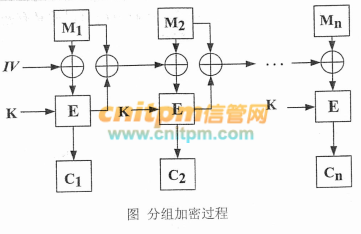第
65题: 在下图给出的加密过程中Mi,i=1,2,…,n表示明文分组,Ci,i=1,2,…,n表示密文分组,IV表示初始序列,K表示密钥,E表示分组加密。该分组加密过程的工作模式是( )。

A.ECB
B.CTR
C.CFB
D.PCBC
答案解析与讨论:
www.cnitpm.com/st/4114621173.html第
66题: 目前网络安全形势日趋复杂,攻击手段和攻击工具层出不穷,攻击工具日益先进, 攻击者需要的技能日趋下降。以下关于网络攻防的描述中,不正确的是( )。
A.嗅探器Sniffer工作的前提是网络必须是共享以太网
B.加密技术可以有效抵御各类系统攻击
C.APT的全称是高级持续性威胁
D.同步包风暴(SYN Flooding)的攻击来源无法定位
答案解析与讨论:
www.cnitpm.com/st/411479305.html第
67题: ( )攻击是指借助于客户机/服务器技术,将多个计算机联合起来作为攻击平台,对一个或多个目标发动DoS攻击,从而成倍地提高拒绝服务攻击的威力。
A.缓冲区溢出
B.分布式拒绝服务
C.拒绝服务
D. 口令
答案解析与讨论:
www.cnitpm.com/st/4114823197.html第
69题: 移位密码的加密对象为英文字母,移位密码采用对明文消息的每一个英文字母向前推移固定Key位的方式实现加密。设key=3,则对应明文MATH的密文为( )。
A. OCVJ
B. QEXL
C. PDWK
D. RFYM
答案解析与讨论:
www.cnitpm.com/st/4115021966.html第
70题: 基于公开密钥的数字签名算法对消息进行签名和验证时,正确的签名和验证方式是( )。
A.发送方用自己的公开密钥签名,接收方用发送方的公开密钥验证
B.发送方用自己的私有密钥签名,接收方用自己的私有密钥验证
C.发送方用接收方的公开密钥签名,接收方用自己的私有密钥验证
D.发送方用自己的私有密钥签名,接收方用发送方的公开密钥验证
答案解析与讨论:
www.cnitpm.com/st/4115119792.html第
71题: The modern study of symmetric-key ciphers relates mainly to the study of block ciphers and stream ciphers and to their applications. A block cipher is, in a sense, a modern embodiment of Alberti's polyalphabetic cipher: block ciphers take as input a block of (71 )and a key, and output a block of ciphertext of the same size. Since messages are almost always longer than a single block, some method of knitting together successive blocks is required. Several have been developed, some with better security in one aspect or another than others. They are the mode of operations and must be carefully considered when using a block cipher in a cryptosystem.
The Data Encryption Standard (DES) and the Advanced Encryption Standard (AES) are( 72 )designs which have been designated cryptography standards by the US government (though DES's designation was finally withdrawn after the AES was adopted). Despite its deprecation as an official standard, DES (especially its still-approved and much more secure triple-DES variant) remains quite popular; it is used across a wide range of applications, from ATM encryption to e-mail privacy and secure remote access. Many other block ciphers have been designed and released, with considerable variation in quality. Many have been thoroughly broken. See Category: Block ciphers.
Stream ciphers, in contrast to the ‘block’type, create an arbitrarily long stream of key material, which is combined ( 73 )the plaintext bit-by-bit or character-by-character, somewhat like the one-time pad. In a stream cipher, the output( 74 )is created based on an internal state which changes as the cipher operates. That state change is controlled by the key, and, in some stream ciphers, by the plaintext stream as well. RC4 is an example of a well-known, and widely used, stream cipher; see Category: Stream ciphers.
Cryptographic hash functions (often called message digest functions) do not necessarily use keys, but are a related and important class of cryptographic algorithms. They take input data (often an entire message), and output a short fixed length hash, and do so as a one-way function. For good ones, ( 75 ) (two plaintexts which produce the same hash) are extremely difficult to find.
Message authentication codes (MACs) are much like cryptographic hash functions, except that a secret key is used to authenticate the hash value on receipt. These block an attack against plain hash functions.
(71)
A.plaintext
B.ciphertext
C.data
D.hash
(72)
A.stream cipher
B.hash function
C.Message authentication code
D.Block cipher
(73)
A.of
B.for
C.with
D.in
(74)
A.hash
B.stream
C.ciphertext
D.plaintext
(75)
A.collisions
B.image
C.preimage
D.solution
答案解析与讨论:
www.cnitpm.com/st/4115223167.html
